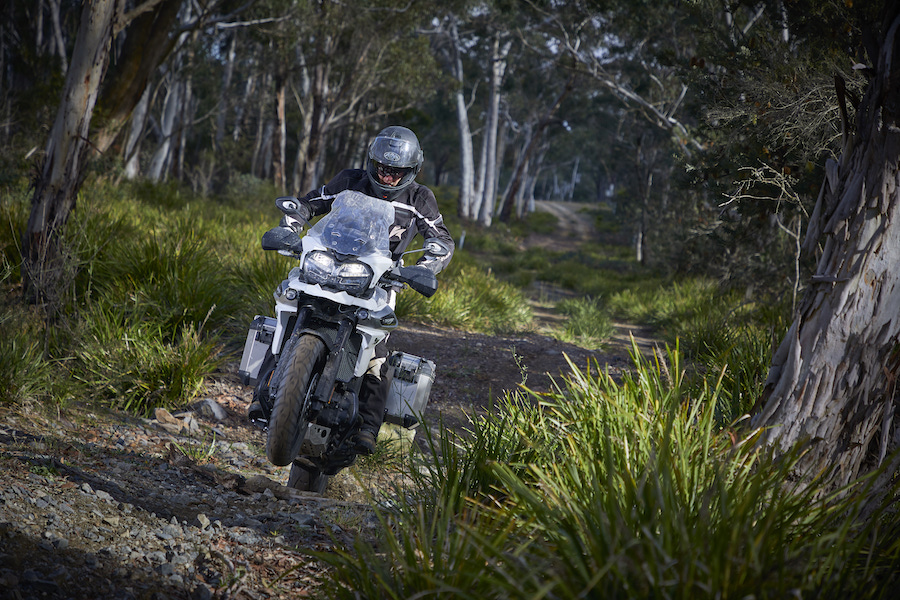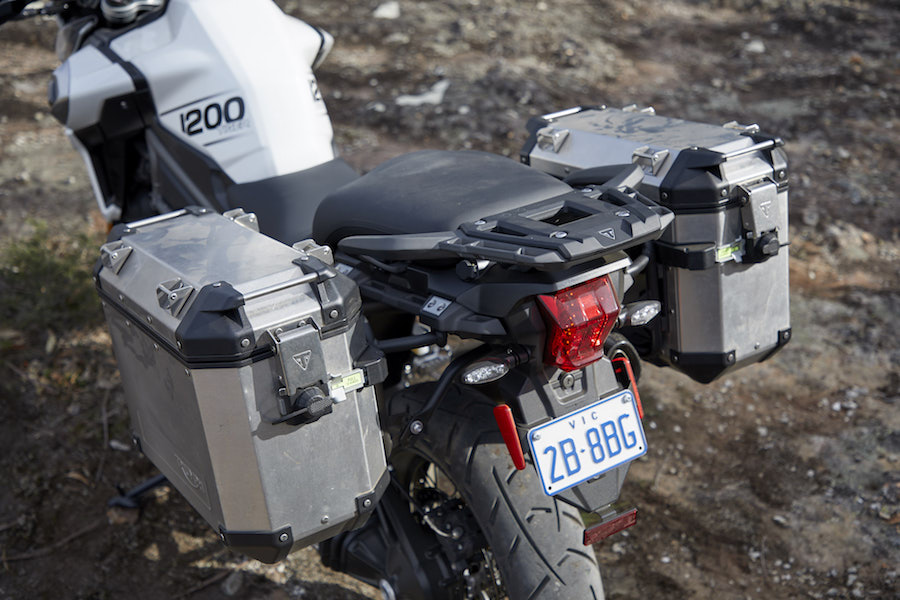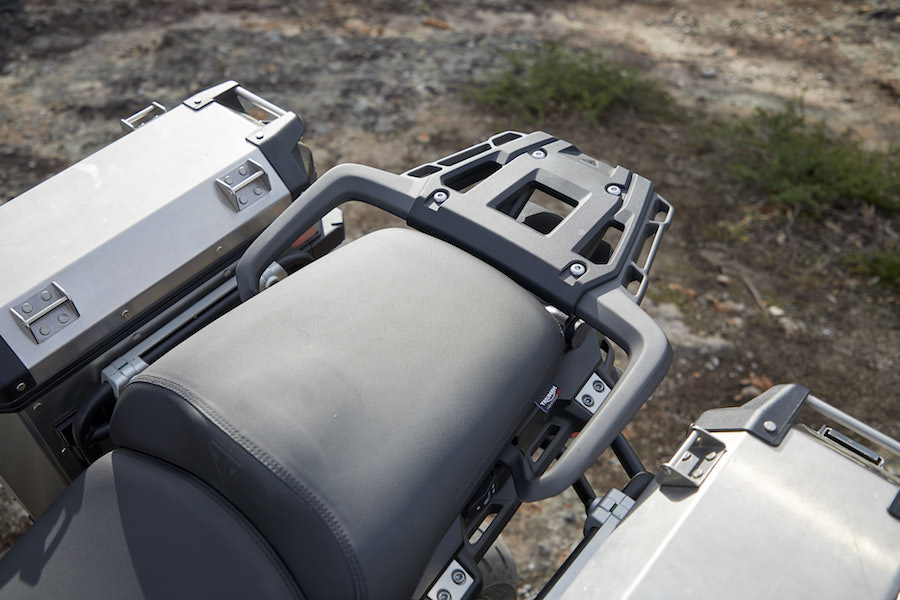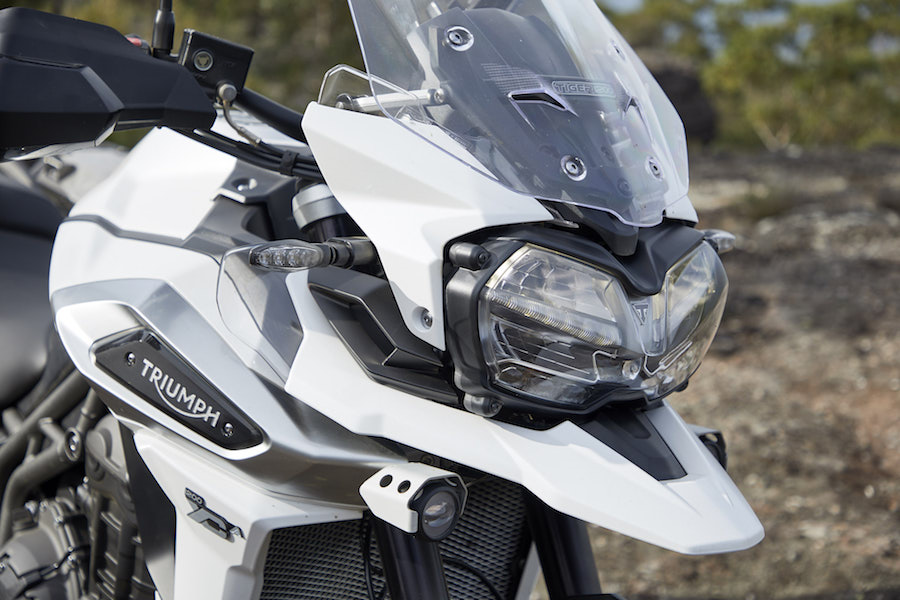The big Triumph is really in its element on the bitumen, but can also cut it off-road
Sometimes the dice can roll in your favour. Like when the sun is barely up, the thermometer is nowhere near double figures and the wind-chill is cutting through you, and you haven’t even started moving yet. But then a key comes through the air, which you catch, and open your hand to find it’s the one best suited to grim weather – the Triumph.
When it comes to adventure touring in supreme comfort, particularly when the weather’s foul, Triumph’s new Tiger 1200 XCA rules the roost in this pack. The mighty British triple features the largest (electrically adjustable) screen of the lot, and comes with heated grips with full wrap-around hand guards, and even a heated seat! And the ergonomics cocoon you in the bike; you’re well protected from the elements.
While the other riders were getting smashed in the wind and their fingertips were turning blue on the cold early-morning run out of Crookwell, the Tiger and I were, quite literally, purring along, smiling like the cat that caught the canary.
For 2018, Triumph’s biggest ADV machines have seen the previous Explorer badge dropped, as the 1200 XC (wire wheels) and XR (cast wheels) models have been renamed simply Tiger, which brings them in line with the brand’s popular 800cc adventure machines.
This XCA is the most dirt-ready of the Tiger 1200 line-up and now benefits from a 10kg weight reduction over the previous model, as well as a raft of engine, chassis, suspension and detail updates, all aimed at making the big cat a more serious off-road contender.
The XCA’s suite of electronics is arguably the most impressive of the upgrades, with a new Inertial Measurement Unit, integrated braking system, optimised cornering ABS and traction control, and ride-by-wire throttle combining to now offer six riding modes. The modes include Road, Rain, Sport, Rider (which is fully customisable), Off-Road (rear ABS off, limited traction control intervention) and a new Off Road Pro mode that disables ABS and TC, and brings it into line with its European rivals.

While mode changes and settings are easily completed via the mode, home and joystick
buttons on the switchblocks, with relevant info clearly displayed on the new five-inch TFT dash display, the only chink in the Tiger’s mode-selection armour is the need to come to a halt if you want to switch between modes that involve a change in the ABS or traction-control settings.
Triumph’s trademark triple-cylinder engine offers no shortage of power (104kW/139hp) and a mountain of torque (122Nm), and you can use the sweet quickshifter to either short-shift and lope along in a gentlemanly fashion, or hold each gear and let the turbine-like shrill reverberate across the hills as the ground disappears beneath you.
Overall, the Tiger’s power delivery is strong, smooth and tractable, and is a big part of what makes the bike such a capable and comfortable adventure touring mount.

Triumph’s Semi-Active Suspension utilising WP components does an impressive job, with sensors detecting data from wheel travel, lean angle and traction to adjust suspension, braking and power delivery as you ride. The suspension can also be adjusted in increments from Comfort to Sport settings, once again via the joystick located on the left side switchblock.
On sealed, bumpy backroads, the Tiger benefits from being set towards Comfort, to give more ride compliance, before being boosted back toward Sport for spirited off-road riding, which also helped to lift the belly of the bike and give a little more ground clearance.
Such adjustability is beneficial for big adventure bikes, which cover such varied riding conditions in a typical day, and can be ridden solo on one outing but loaded up with a pillion and luggage the next.
At 272kg wet with (empty) panniers, the Tiger is no lightweight, but belies its heft well, particularly on the tar, where it is a settled and confidence-inspiring handler.
Sweet stand-up ergos from the well sculpted tank/seat junction and the wide bars and sizeable off-road ’pegs help you take the Tiger by the tail when you hit the bush, as it works best in the dirt when ridden in a dominant fashion, which is the case with all the 1000cc-plus adventure beasts.
The Tiger impressed by going about its business with minimum fuss, and confidently and comfortably handling all that was thrown at it over the three days.
At $29,300 plus on-roads, the XCA isn’t cheap, but it comes with a list of other inclusions – LED lights, fog lights, cruise control, hill hold control, heated grips, heated seats, crash bars, power sockets, centrestand, aluminium sump guard, radiator guard, shift assist, Arrow titanium/carbon-fibre muffler, Brembo Monobloc front stoppers and more. It should be on the radar of all litre-plus adventure bike buyers.

Like
The Tiger is fully-kitted as it rolls off the showroom floor, from its electronically adjustable screen to meaty off-road-ready foot pegs. All riders commented how the Tiger was so comfortable to simply get on and ride, on tar and dirt roads alike, especially if your agenda involves pounding out big-mile days.
Dislike
Having to come to a complete stop to change riding modes that involve a change in ABS or TC settings. The Tiger had a thirst for fuel on test and, with just a 20L tank, had the shortest range of the four 1000cc-plus bikes, so outback touring, with a pillion, fully loaded, into a headwind, could be touch-and-go between roadhouses.
Fun Fact
The previous Explorer versions of Triumph’s 1200cc adventure bikes are now called Tigers. Bonus fact: What do you call a group of Tigers? An ambush, grrrr.








